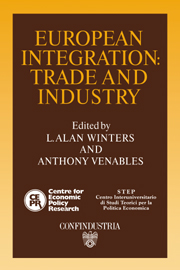Book contents
- Frontmatter
- Contents
- List of figures
- List of tables
- Preface
- Acknowledgements
- List of conference participants
- 1 European integration: trade and industry
- 2 Completing the internal market in the EC: factor demands and comparative advantage
- Discussion
- 3 External effects and Europe's integration
- Discussion
- 4 The quality and production of textiles and clothing and the completion of the internal market
- Discussion
- 5 Competition and imports in the European market
- Discussion
- 6 The structure and determinants of East–West trade: a preliminary analysis of the manufacturing sector
- Discussion
- 7 1992 and EFTA
- Discussion
- 8 Technology policy in the completed European market
- Discussion
- 9 Corporation tax, foreign direct investment and the single market
- Discussion
- 10 Japanese direct manufacturing investment in Europe
- Discussion
- Index
8 - Technology policy in the completed European market
Published online by Cambridge University Press: 07 September 2010
- Frontmatter
- Contents
- List of figures
- List of tables
- Preface
- Acknowledgements
- List of conference participants
- 1 European integration: trade and industry
- 2 Completing the internal market in the EC: factor demands and comparative advantage
- Discussion
- 3 External effects and Europe's integration
- Discussion
- 4 The quality and production of textiles and clothing and the completion of the internal market
- Discussion
- 5 Competition and imports in the European market
- Discussion
- 6 The structure and determinants of East–West trade: a preliminary analysis of the manufacturing sector
- Discussion
- 7 1992 and EFTA
- Discussion
- 8 Technology policy in the completed European market
- Discussion
- 9 Corporation tax, foreign direct investment and the single market
- Discussion
- 10 Japanese direct manufacturing investment in Europe
- Discussion
- Index
Summary
Introduction
While the major aim of completing the European market is the removal of a plethora of barriers to the free movement of goods and factors in order to realise significant static improvements in resource allocation, a clear secondary aim is the enhancement of dynamic efficiency, and these are clearly seen as complementary rather than competing objectives.
The Cecchini Report (1988) thus paints a glowing picture of a virtuous circle whereby market liberalisation spurs greater innovative activity, which in turn leads to enhanced competition and the regaining of technological leadership:
Market integration brings with it a number of factors giving European firms the chance to regain technological leadership. Among these factors [are]: European market liberalization and growth; the removal of market entry barriers (e.g. standards); the creation of new companies, particularly in the high tech sectors; and the rapid development of cross-frontier business cooperation. Only when European companies regain this leadership can they call the shots – or, in the language of economics, go from being ‘price takers’ to ‘price makers’.
In short, strengthening European competitivity (sic) leads, so to speak, to the reconquest of the European market.
The emphasis on cooperative R & D arrangements reflects this new-found enthusiasm for cooperation. Thus while Art. 85 of the Treaty of Rome condemns agreements between firms and collusive practices which may restrict trade, the White Paper on the single market, Completing the Internal Market, states that ‘the removal of internal boundaries and the establishment of free movement of goods and capital and the freedom to provide services are clearly fundamental to the creation of the internal market. Nevertheless, Community action must go further and create an environment or conditions likely to favour the development of cooperation between undertakings’.
- Type
- Chapter
- Information
- European IntegrationTrade and Industry, pp. 142 - 161Publisher: Cambridge University PressPrint publication year: 1991



